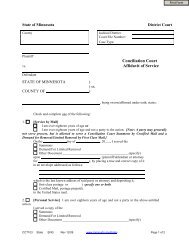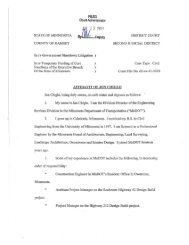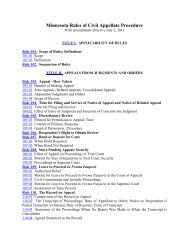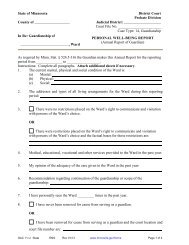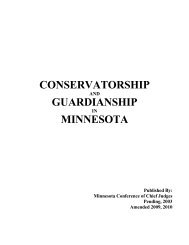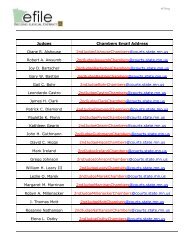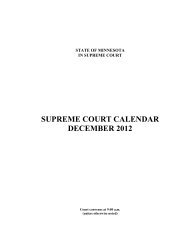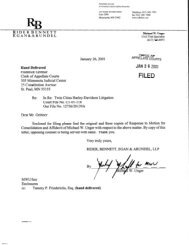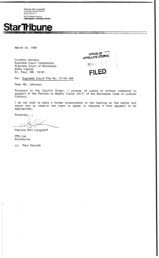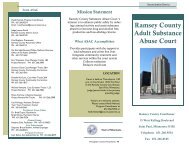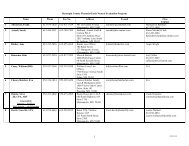MN Advisory Comm Exhibits 1-18 - Minnesota Judicial Branch
MN Advisory Comm Exhibits 1-18 - Minnesota Judicial Branch
MN Advisory Comm Exhibits 1-18 - Minnesota Judicial Branch
Create successful ePaper yourself
Turn your PDF publications into a flip-book with our unique Google optimized e-Paper software.
ci<br />
c<br />
G<br />
EVERY RESIDENT of Hennepin<br />
County was a direct or indirect victim<br />
of these and similar types of white collar<br />
crimes. Losses suffered by businesses<br />
and government were passed on to<br />
consumers and taxpayers in the form of<br />
higher prices, higher taxes and reduced<br />
services.<br />
The dollar loss to the public from<br />
whit,p collar crimes may far exceed that<br />
of slrect crime. and there are indicaticJIlS<br />
tllat SeVcl’Fil typos of’ bvtlito coll;ir<br />
c&rimes arc on the r’isc.<br />
A study of’ 1 I(tnnepin Coullty District<br />
Court records of criminal (IHSC’S arraigned<br />
in 1973 discsloscd only twothirds<br />
as many white collar crimes as<br />
street crimes. But the dollar cost of the<br />
white collar crimes was nearly twoand-a-half<br />
times greater. And the cost<br />
was borne by individuals, groups, business<br />
and government - all vulnerable<br />
to the white collar criminal.<br />
White collar crimes exploit the trust<br />
of an unsuspecting and cooperative victim<br />
through the use of guile or deceit.<br />
Frauds, embezzlements, forgeries and<br />
price-fixing are all types of white collar<br />
crimes.<br />
Individuals trying to save money are<br />
particularly susceptible to frauds,<br />
especially home improvement and auto<br />
repair schemes. As in the case of the<br />
homeowner with a leaking roof, a “good<br />
deal“ often turns out to be fraudulent<br />
and even more costly for the consumer<br />
than an expensive but competent job.<br />
The more elaborate buyers club<br />
10<br />
scheme exploited over 7.000 Midwes-<br />
terners trying to save money through<br />
cooperative buying. Each club member<br />
paid $395 for a lo-year membership in<br />
Mid-America Savers, Inc., of Edina,<br />
and was guaranteed wholesale buying<br />
rights. But the club’s announced 6 per-<br />
cent handling fee was soon increased by<br />
an illegal and hidden 8 percent markup<br />
in the wholesale prices listed in the club<br />
catalog. The club also began charging<br />
down payments, another violation of<br />
the original membership agreement.<br />
By the time the state became aware<br />
of the fraud in October. 1973. the club<br />
owed members $48,000 in down pay-<br />
rncnts and $200.000 in refunds on the<br />
remaining years of memberships.<br />
Another $48,000 was owed to companies<br />
which had delivered merchandise but<br />
had not been paid by the club.<br />
Even through the club officers were<br />
convicted in federal court last summel<br />
and company assets were placed in re-<br />
ceivership, defrauded members and<br />
companies will never receive refunds<br />
or payments.<br />
Mel Vander Meer, a St. Paul postal<br />
inspector who worked on the case, exp-<br />
lained that “all the company money<br />
went into operating and personal ex-<br />
penses, and that’s why you never find a<br />
bundle at the end of these schemes,<br />
even though people think you do.<br />
Ninety-five percent of the time, nothing<br />
is recovered.”<br />
While the need to economize makes<br />
the individual vulnerable to white collar<br />
frauds, the hope of easy gains is equally<br />
dangerous.<br />
Ads for work-at-home schemes, for<br />
example. promise great earnings with<br />
“no experience necessary.” Clipping<br />
newspapers, addresssing envelopes,<br />
assembling items, making clothing and<br />
raising animals are among the jobs of-<br />
fcred. The initial investment by the in-<br />
dividual often exceeds the profits possi-<br />
blc. Although each person loses only a<br />
few dollars. the U.S. Chamber of Con-<br />
mcrcc estimates that, nationally. $500<br />
million is milked from the public each<br />
year through these schemes.<br />
Mail order investment frauds also<br />
victimize people seeking financial gains<br />
for no work. Recently a Twin Cities<br />
man advertised silver dollars in the<br />
newspaper, priced at less than market<br />
value. He collected $1,900 by mail in<br />
three weeks, sent no silver dollars and<br />
left town.<br />
On a more devastating scale, 14 Twin<br />
Cities residents lost a total of $31,000<br />
during the first six months of 1973 to a<br />
man who promised investment gains on<br />
the commodities market. False charts<br />
and a fluid sales technique won the trust<br />
of the victims, but their money was sto-<br />
len, not invested. The loss represented<br />
the life savings of several of the vic-<br />
tims.<br />
And occasionally an individual who is<br />
neither trying to save nor earn money is<br />
victimized through no fault or action 01<br />
his own. Last year, some <strong>Minnesota</strong> re-<br />
sidents discovered that they had been<br />
bilked by car dealers turning back<br />
odometers and artificially increasing<br />
the value of used cars. No one knows yet<br />
-- and some victims may never knoL$<br />
they were “taken” -- how many p~~ol)lc~<br />
were defrauded or what the dollar loss<br />
has been.<br />
On a more personal level. mtsmbcr!:<br />
of a Minneapolis church bowling Irnguc<br />
paid $1.800 in dues to the leaguc~ trras-<br />
urcr to pay for the annual banquc~t.<br />
After the members I’inishcd their ban-<br />
quet dinner and received their trophies.<br />
the treasurer slowly rose and haltingly<br />
announced that there was no mono’)’ to<br />
pay for the banquet. He had spent the<br />
dues on himself,<br />
While customers, clients and club<br />
members are prey to many schemes.<br />
businesses also suffer from frauds at<br />
the hands of their own customers and<br />
employees.<br />
Jerry &huller. part owner of Tower<br />
Grocery and Ralph and Jerry’s in Min-<br />
neapolis, estimated his losses at both<br />
stores from bad and forged checks at<br />
over $1,000 per year. Schuller’s Tower<br />
Grocery has been held up three times in<br />
the last year, but his losses to the armecl<br />
criminals were considerably less than<br />
losses to the bad check artists.<br />
William Rose of Kick’s Liquors in<br />
Minneapolis said that he loses a ,‘sub-<br />
stantial amount” of money each year to<br />
bad checks and forgeries.<br />
“It’s equivalent to stealing,” Rose<br />
said. “The only difference is that the)<br />
don’t use a gun.” Rose estirnates that<br />
several thousand dollars of “pure los-<br />
ses” are absorbed by Kick’s each year,<br />
Brooks Superettes in the Twin Cities<br />
loss nearly 2.5 percent of its annual<br />
gross earnings to “internal and exter-<br />
nal frauds,” estimates Keith Carlson.<br />
president. Losses of the 20 Brooks<br />
stores probably exceed $100,000 annu-<br />
ally from bad checks. forgeries. shop-<br />
lifting and employee theft, Carlson<br />
said. All Brooks employees --- man-<br />
“It’s equivalent<br />
to stealing.<br />
The difference<br />
is . . . they<br />
don’t use<br />
a gun.”<br />
Greater Minneapolis




